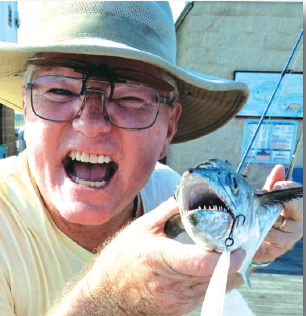Pier & Shore Fishing Outlook 7/27/22
Pier & Shore Fishing Outlook
By David “The Pierpounder” Thornton
Well the so-called “Dog Days of Summer” may be behind us, but we still have plenty of sultry weather looking ahead. In fact August is often the beginning of the Cape Verde portion of the Atlantic hurricane season. Even though storms may form just about anywhere in the tropics this time of year, those that have a long fetch across the ocean are some of the most powerful. And when not tracking Atlantic tropical systems, we will still be quite occupied with plenty of thundershowers and storms that pop up daily. In fact now, it is rare to not at least see some thunderheads at some point during the course of most every day.
This in part because the water temperature in the Gulf and back bays trending in the middle to upper 80s contributes to high humidity and the volatile atmosphere. Early morning anglers should be especially wary of lightning which can often be expected, and should always be respected.
The heat plus rain borne nutrients have brought about another round of June grass along the beaches. Though so far it has not been as widespread or bothersome as last year’s historic infestation. But at times, about the only way to avoid June grass is to not bottom fish at all. Fortunately, bluefish, spanish mackerel, and ladyfish have been quite cooperative recently for surf and jetty anglers early in the day. Often the action is short-lived, and over at or soon after sunup. Popping surface plugs and ¾ to 1 ½ ounce silver spoons are great lures to fool these fish. Just be sure to at least use a couple of feet of heavy monofilament line to protect your lure investment from those sharp teeth. This is the time of year those popular Bubble Rigs can be so effective too. And they cast well, even into a moderate breeze.
Of course it is hard to beat live bait for many popular fish species, especially at times when they get a bit picky. Warmer waters, along with an abundance of natural food can make gamefish get finicky periodically. Primarily with less than ideal feeding conditions. Water level, tidal current, water clarity, amount of light, and wind’s affect on the water surface and below greatly influence the bite on a daily basis.
So anticipating a bite can help you be on station and prepared when the action commences and result in more fish being caught. Just having a backup combo, rigged and ready can keep you in the game in case you get cut off or need to re-rig.
Jellyfish are another product of warm midsummer saltwater that should be on the mind of shorebound anglers, especially wade fishers. Though most species are innocuous to humans, Chrysaora quinquecirrha, called Sea-nettle or Atlantic stinging jellyfish is a common seasonal deterrent to folks getting in the water whenever they are present. Sometimes they can be avoided by moving to another beach, but usually any serious infestation is area wide.
Even the bay waters are not immune to occasional intrusions of them. Staying out of the water does not totally prevent the possibility of being stung either.
Inevitably some tentacles may wrap around fishing line or rope. And tiny pieces may slough off, then come in contact with skin causing itching or stinging. Fortunately the stings are relatively mild and the pain can be negated by rinsing with cool water and soap, and applying some baking soda on the rash.
Beach fishermen have been able to find some ‘keeper’ pompano recently. But those have been relatively rare to find even by anglers seeking them exclusively. For instance during the recent three day Alabama Deep Sea Fishing Rodeo only 17 pompano were weighed in, and 3rd place was less than two pounds.
Of course many more were caught, but that is a pretty good indication of the degree of difficulty in finding quality pompano at this point in the summer.
Fortunately, the other species already mentioned have kept thing interesting for a lot of surf anglers. Even some large jack crevalle have been caught from the surf and still some nice speckled trout are schooling along the beaches. Though their numbers may be thinning out some now with the New moon period darkening the night skies. But that should aid the bite around dock and pier lights, especially for “white trout”.
These are Sand and Silver seatrout which typically run about a pound and can be quite plentiful around these structures in the summer. Lighted docks can be especially productive using live baits (shrimp or minnows), or small artificials that resemble the natural prey items these fish feast upon. There is a good chance of encountering speckled trout or redfish, as well as flounder in the locations also.
Pier fishing has been about average for this time of year too. The tarpon run usually slacks off in August, and indications are that is already beginning to occur. But with all the dying baitfish around, there have still been a few king mackerel landed from the pier. Though getting them past the gauntlet of sharks is often the biggest challenge. Likewise, there have been some nice spanish mackerel caught at times, though more on live bait than on artificials. There are still some nice spadefish around the mid platform, as we

